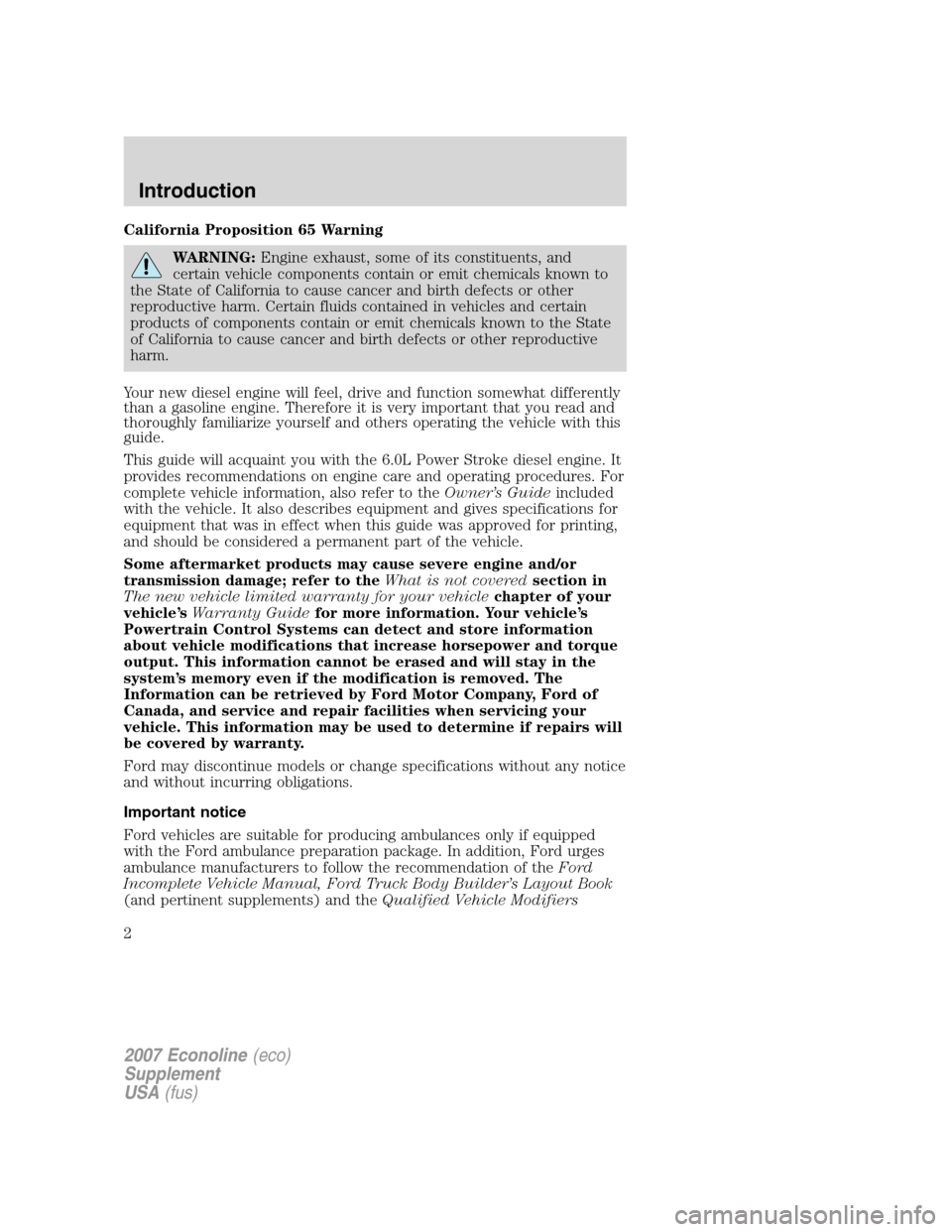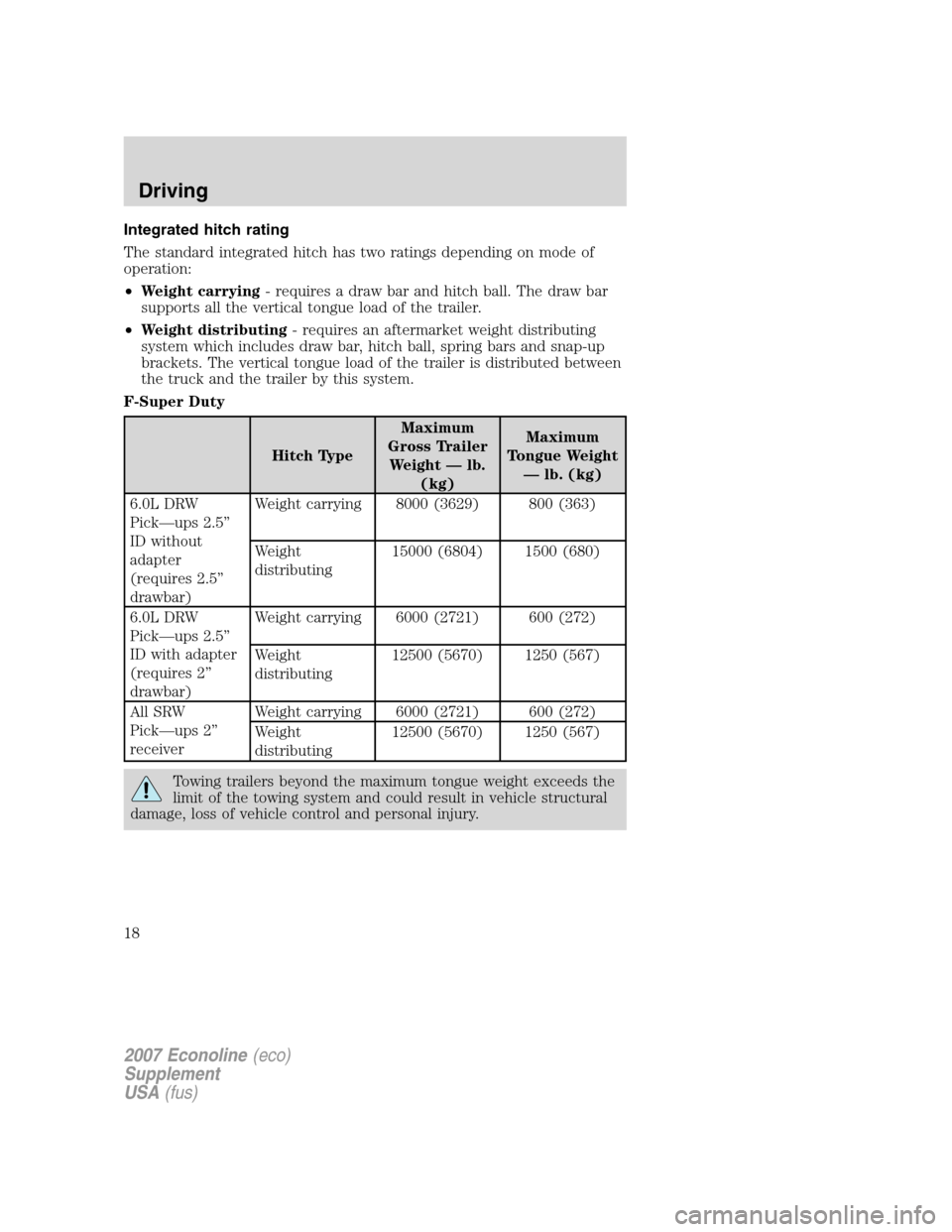Page 2 of 72

California Proposition 65 Warning
WARNING:Engine exhaust, some of its constituents, and
certain vehicle components contain or emit chemicals known to
the State of California to cause cancer and birth defects or other
reproductive harm. Certain fluids contained in vehicles and certain
products of components contain or emit chemicals known to the State
of California to cause cancer and birth defects or other reproductive
harm.
Your new diesel engine will feel, drive and function somewhat differently
than a gasoline engine. Therefore it is very important that you read and
thoroughly familiarize yourself and others operating the vehicle with this
guide.
This guide will acquaint you with the 6.0L Power Stroke diesel engine. It
provides recommendations on engine care and operating procedures. For
complete vehicle information, also refer to theOwner’s Guideincluded
with the vehicle. It also describes equipment and gives specifications for
equipment that was in effect when this guide was approved for printing,
and should be considered a permanent part of the vehicle.
Some aftermarket products may cause severe engine and/or
transmission damage; refer to theWhat is not coveredsection in
The new vehicle limited warranty for your vehiclechapter of your
vehicle’sWarranty Guidefor more information. Your vehicle’s
Powertrain Control Systems can detect and store information
about vehicle modifications that increase horsepower and torque
output. This information cannot be erased and will stay in the
system’s memory even if the modification is removed. The
Information can be retrieved by Ford Motor Company, Ford of
Canada, and service and repair facilities when servicing your
vehicle. This information may be used to determine if repairs will
be covered by warranty.
Ford may discontinue models or change specifications without any notice
and without incurring obligations.
Important notice
Ford vehicles are suitable for producing ambulances only if equipped
with the Ford ambulance preparation package. In addition, Ford urges
ambulance manufacturers to follow the recommendation of theFord
Incomplete Vehicle Manual, Ford Truck Body Builder’s Layout Book
(and pertinent supplements) and theQualified Vehicle Modifiers
2007 Econoline(eco)
Supplement
USA(fus)
Introduction
2
Page 14 of 72

The following cold weather idling guidelines must be followed:
•Avoid idling the engine for more than 10 minutes at a time.
•Use Motor Craft Cetane Index improvers of a non-alcohol based from a
reputable manufacturer.
•Maintain the engine cooling system properly.
•Do not shut the engine down after an extensive idling period (10
minutes or more). Drive the vehicle for several miles with the engine
at normal operating temperatures under a moderate load to burn off
any accumulated carbon and varnish.
•Consider using an engine block heater.
•For extended idle times use an approved idle speed increase device.
Winter operating tips for Arctic operation -20°F (-29°C) and below
The following information is provided as a guideline only, and is not
intended to be the only source of possible solutions in resolving extreme
cold temperature issues.
Starting Aids:
The use of the factory engine block heater (refer toUsing the engine
block heater (if equipped)in theDrivingchapter of theOwner’s
Guide) and oil pan heaters (aftermarket) will assist in engine starting, in
extreme cold ambient temperatures.
Do not use starting fluid, such as ether, in the air intake system
(see air cleaner decal). Such fluid could cause immediate
explosive damage to the engine and possible personal injury.
Idle control:
For periods of extended idle, the throttle should be set at an rpm, which
is sufficient to keep the engine at normal operating temperatures. This
action can reduce the amount of engine damaging deposits.
•The 6.0L diesel engine contains a unique�Cold Weather – Idle up
feature�calibration strategy within the Powertrain Control Module
(PCM). Under the appropriate conditions, the strategy will
automatically elevate the engine idle speed after 130 seconds of idling
in cold ambient temperatures. For this feature to be activated the
truck must be in P (Park) (for automatic transmission), in neutral (for
manual transmission) with the park brake applied and engine oil
temperature below 158°F (70°C). This strategy raises the rpm to a
2007 Econoline(eco)
Supplement
USA(fus)
Driving
14
Page 18 of 72

Integrated hitch rating
The standard integrated hitch has two ratings depending on mode of
operation:
•Weight carrying- requires a draw bar and hitch ball. The draw bar
supports all the vertical tongue load of the trailer.
•Weight distributing- requires an aftermarket weight distributing
system which includes draw bar, hitch ball, spring bars and snap-up
brackets. The vertical tongue load of the trailer is distributed between
the truck and the trailer by this system.
F-Super Duty
Hitch TypeMaximum
Gross Trailer
Weight — lb.
(kg)Maximum
Tongue Weight
— lb. (kg)
6.0L DRW
Pick—ups 2.5”
ID without
adapter
(requires 2.5”
drawbar)Weight carrying 8000 (3629) 800 (363)
Weight
distributing15000 (6804) 1500 (680)
6.0L DRW
Pick—ups 2.5”
ID with adapter
(requires 2”
drawbar)Weight carrying 6000 (2721) 600 (272)
Weight
distributing12500 (5670) 1250 (567)
All SRW
Pick—ups 2”
receiverWeight carrying 6000 (2721) 600 (272)
Weight
distributing12500 (5670) 1250 (567)
Towing trailers beyond the maximum tongue weight exceeds the
limit of the towing system and could result in vehicle structural
damage, loss of vehicle control and personal injury.
2007 Econoline(eco)
Supplement
USA(fus)
Driving
18
Page 22 of 72
4. Make the final connection of the negative (-) cable to an exposed
metal part of the disabled vehicle’s frame or chassis, away from the
batteries.Do notuse fuel lines, brake lines, exhaust components or the
battery trays asgroundingpoints.
Do not connect the end of the second cable to the negative (-)
terminal of the battery to be jumped. A spark may cause an
explosion of the gases that surround the battery.
5. Ensure that the cables are clear of moving parts or any fuel delivery
system, brake system or exhaust system parts.
Jump starting
1. Start the engine of the booster vehicle and run the engine at
moderately increased speed.
2. Start the engine of the disabled vehicle.
3. Once the disabled vehicle has been started, run both engines for an
additional three minutes before disconnecting the jumper cables.
2007 Econoline(eco)
Supplement
USA(fus)
Roadside emergencies
22